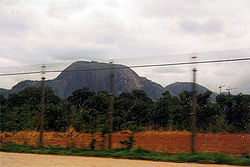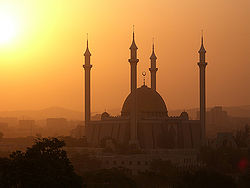Abuja
| Abuja, Nigeria | |
| Abuja, Nigeria. | |
| Phase I and II represents Abuja city on a map of FCT | |
| Coordinates: | |
|---|---|
| Territory | Federal Capital Territory |
| Government | |
| - Minister | Aliyu Modibbo Umar |
| Area | |
| - Total | 713 km² (275.3 sq mi) |
| - Land | 713 km² (275.3 sq mi) |
| Population (2006) | |
| - Total | 778,567 [1] |
| Time zone | WAT (UTC+1) |
| Website: http://www.fct.gov.ng/ | |
Abuja, officially Abuja Municipal Area Council, is the capital city of Nigeria, and is known as the best purpose-built city in Africa as well as one of the wealthiest and most expensive. Abuja is a "planned" city, as it was mainly built in the 1980s and officially became Nigeria's capital on December 12, 1991, replacing the role of the previous capital Lagos. As of the 2006 census, the Federal Capital Territory has a population of 778,567.
Geography
Located approximately 300 miles (480 km) northeast of Lagos, in the centre of Nigeria in the Federal Capital Territory, Abuja lies at 1180 feet (360 meters) above sea level and has a cooler climate and less humidity than is found in Lagos. Abuja's geography is defined by Aso Rock, a 400-metre monolith left by water erosion. "Aso" means "victorious" in the language of the (now displaced) Asokoro ("the people of victory").
Abuja undergoes three weather conditions annually. This includes a warm, humid rainy season, from April to October, and a blistering dry season, when daytime temperatures can soar as high as 40 degrees. In between the two seasons, there is a brief interlude of harmattan occasioned by the North East Trade Wind, with the main feature of dust haze, intensified coldness and dryness. The annual total rainfall is in the range of 1100mm to 1600mm.
Abuja has several parks and green areas with the largest one being Millennium park, which was designed by world renowned architect Manfredi Nicoletti and was officially opened by Queen Elizabeth II of England.
Sights include the Nigerian National Mosque and the Nigerian National Christian Centre. The city is served by the Nnamdi Azikiwe International Airport, while Zuma Rock lies nearby. However, the population on the semi-developed edges of the city are living in shanty towns such as Karu, which was built to house the capital's civil servants and lower income families, and has no running water, sanitation or electricity.
History
Since Nigeria's independence from the United Kingdom, on October 1, 1960, ethnic and religious divisions required the creation of a capital city in a location deemed neutral to all parties. Also, Lagos's population boom made that city overcrowded and conditions squalid. The site for a new capital was chosen because of its central location, easy accessibility, pleasant climate, low population density, and the availability of land for future expansion.
A consortium of three American firms: PRC Corporation; Wallace, McHarg, Roberts and Todd; and, Archisystems, created a master plan for Abuja. Renowned Japanese architect Kenzo Tange refined the design. Construction began in the late 1970s, but economic and political instability meant the city’s initial stages were not complete until the late 1980s.
Most countries moved their embassies to Abuja and maintain their larger former embassies as consulates in the commercial capital, Lagos.
Administration
The Presidential Complex, National Assembly, Supreme Court and much of the town extend to the south of the rock. Abuja is the headquarters of the Economic Community of West African States (ECOWAS), as well as its military arm, ECOMOG. It also has the regional headquarters of OPEC.
The city’s Phase one districts are: Abuja Central, which is the city's principal Business Zone and includes the National Assembly, the city hall, national cultural institutes, and other government-related offices, Garki, Wuse, Maitama, which is exclusive and is the location of European embassies, and Asokoro. Phase two districts are: Kado, Durumi, Gudu, Utako and Jabi. Phase 3 Districts are: Mabuchi, Katampe, Wuye and Gwarimpa. There are also five suburban districts, which are Nyanya, Karu, Gwagwalada, Kubwa, and Jukwoyi.
Along the Airport Road are clusters of satellite settlements these are namely: Lugbe, Chika, Kuchigworo and Pyakassa. Other satellite settlements are Idu (The Main Industrial Zone), Mpape, Karimu, Gwagwa, Dei-Dei (housing the International Livestock market and also International Building materials market).
Economy
Abuja International Airport is the only airport in Abuja. The airport with an international and local terminal is under going serious upgrades in order to make it ready to host an event such as the Commonwealth games. Abuja also has a running and efficient BRT and green cab system. Construction is underway for an LRT system for the city. Abuja does not as yet have a connection to the national railway network of Nigeria.
Abuja competed with but lost out to Glasgow, Scotland, to host the Commonwealth Games in 2014.
Demographics
Abuja and the FCT have experienced a huge population growth; it has been reported that some areas around Abuja have been growing at 20 percent to 30 percent.
General landmarks
- Central Bank of Nigeria headquarters
- Ship house, Ministry of Defence building
- Aso Rock, official residence of the President of Nigeria
- Zuma Rock
- NNPC towers
- Abuja International Conference Centre African Hall
- Gurara Falls
- Eagle Square
- National Assembly building in Abuja
- Central District
- Nigerian Communications Commission building
- Maitama District home of the embassies
- National Library
- National Mosque
- National Ecumenical Centre (National Church)
- Abuja Stadium
- The Velodrome
- Nnamdi Azikwe International Airport
- Strabag Hills
- Usuma Dam
- Usuma River
- Jabi River
- Gurara River
- Abuja Love Garden
- Abuja Amusement Park
- Abuja Zoological Park
- IBB Golf Centre
- Ecowas Secretariat
- National Women Development Centre
- Ushafa Pottery Centre
- Ladi Kwali Pottery Centre
- Giri Pottery Centre
- Millennium park
ReferencesISBN links support NWE through referral fees
External links
- Official site of Nigeria's Federal Capital Territory (FCT) and City of Abuja
- Abuja.Net
- Abuja Bid Announcement
- Pictures of Abuja
- Abujacity.com
- Interactive Maps and Sat Navs to travel around.
Credits
New World Encyclopedia writers and editors rewrote and completed the Wikipedia article in accordance with New World Encyclopedia standards. This article abides by terms of the Creative Commons CC-by-sa 3.0 License (CC-by-sa), which may be used and disseminated with proper attribution. Credit is due under the terms of this license that can reference both the New World Encyclopedia contributors and the selfless volunteer contributors of the Wikimedia Foundation. To cite this article click here for a list of acceptable citing formats.The history of earlier contributions by wikipedians is accessible to researchers here:
The history of this article since it was imported to New World Encyclopedia:
Note: Some restrictions may apply to use of individual images which are separately licensed.




